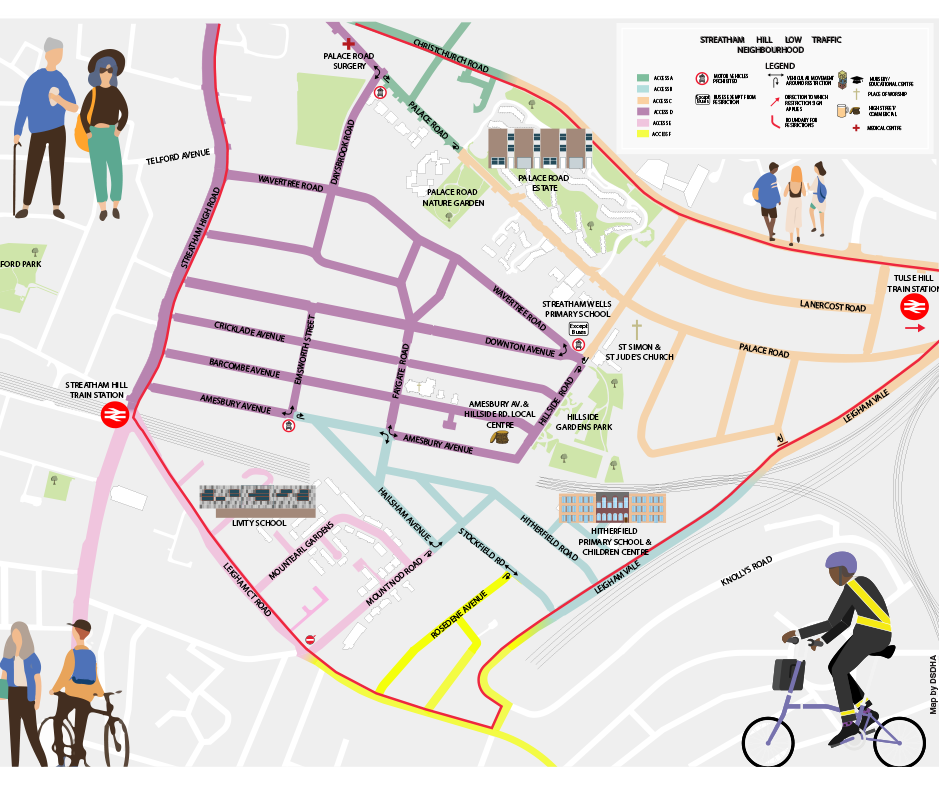Home
Overview: Streatham Hill LTN
Overview: Streatham Hill LTN
Introduction:
The Streatham Hill Low Traffic Neighbourhood (LTN) was introduced to reduce traffic volumes and make it safer and easier for people to walk, wheel and cycle. Reducing traffic in the area will help to achieve priorities within our Transport Strategy, including:
Improve road safety for all users
Encourage travel in healthier, more active ways
Support the local economy and placemaking
Improve air quality
We all need to take bold action to reduce car journeys where possible, to improve the borough’s air quality and tackle the climate emergency. The main objectives of the LTN programme are to achieve:
A reduction in through motor traffic within LTN areas; and
An overall reduction of motor traffic across the area, when considering boundary roads and the inner area together.
What has happened so far?
The LTN was introduced as an emergency measure during the pandemic in August 2020. Planters, signs and enforcement cameras were used to create a series of five ‘filters’ across the area in August 2020.
‘Filters’ stop motor vehicles cutting through a defined point, however, people walking, cycling and wheeling can still pass through, as can the emergency services and refuse vehicles. All destinations within an LTN remain accessible by motor vehicle, however, the route to each destination may change.
LTN amendment:
We trialled the LTN so we could respond to community and stakeholder feedback and make any changes needed. Originally, the LTN did not include traffic filters in the area to the south of the railway line, but resident and ward councillor feedback made it clear that these were required. We implemented additional filters in this area in May 2021 (covering Hitherfield primary, Dunraven school and Mount Earl Gardens Estate), bringing the area bounded by Leighham Court Road, Leigham Vale and the railway line into the LTN.

Streatham Hill LTN Permanent Traffic Order:
Lambeth’s Climate Action Plan shows that we need to reduce traffic in Lambeth by 27% by 2030 to help avoid the worst impacts of climate change. LTNs are a key part of our strategy to reduce traffic across the borough.
Independent monitoring shows that the Streatham Hill LTN has helped to reduce traffic overall by around 4,500 vehicles a day, meaning there is now more safe space for walking and cycling, to make the area greener, more climate resilient and to build spaces to meet and rest. The level of cycling in the LTN and on boundary roads has increased by over 50%.
In June 2022, the Council took the decision that the Streatham Hill LTN should be implemented under a permanent traffic order. The Council has proceeded with the permanent Streatham Hill LTN scheme, with resumed enforcement from November 17 2022. See more details of the decision here.
LTN Traffic Filter Exemptions:
We have carefully considered the needs of all road users and are proposing exemptions for people and services with specific requirements. Our Exemptions Policy balances the needs of specific users who may need to drive through a filter, whilst still ensuring the scheme remains effective in creating safe space for walking and cycling. These are:
Blue Badge holders including SEND transport (you can apply here for an exemption)
Rapid response healthcare providers
Category 1 Responders under the Civil Contingencies Act 2004
Taxis and fully accessible private hire vehicles
Refuse collection vehicles
These exemptions will be put in place for a permanent scheme.
Next steps
During 2023, we are developing permanent designs for the Streatham Hill LTN. For the latest updates, see “What’s Happening Now?”
This engagement phase has finished

...
